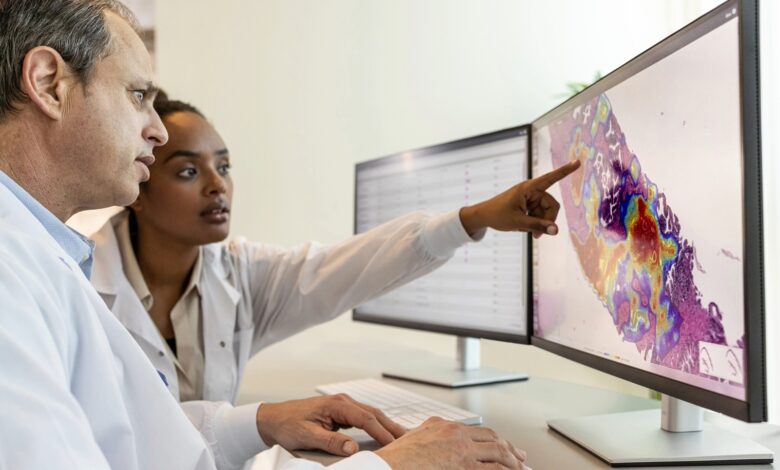
In 2019, Sarah Boyle’s story of breast cancer misdiagnosis rattled the media landscape and was a stark reminder for the healthcare industry about the importance of accuracy in medical diagnostics. Sarah, a mother of one at the time at her diagnosis, was told after having difficulty breastfeeding her baby that she had triple negative breast cancer, a rare form of invasive breast cancer. After undergoing chemotherapy and a double mastectomy, a major surgery where both breasts are removed, Sarah was told that her doctors had wrongly diagnosed her and that she never had cancer in the first place.
Although cases specifically like Sarah’s are rare, she is a part of the larger story of patients whose lives have been adversely affected by a cancer misdiagnosis. A study from researchers at The Johns Hopkins University School of Medicine found that, among the top five most common cancers (lung cancer, breast cancer, colorectal cancer, prostate cancer, and melanoma), rates of diagnoses that have been either meaningfully delayed or missed altogether are high, with estimates ranging from 22.5% for lung cancer diagnoses to 8.9% for breast cancer diagnoses.
However, this is hopefully a story of the past with the advent of new technology solutions that are helping to bridge gaps in health equity and enable pathologists to provide accurate and timely diagnoses to patients. When we look to the future of cancer diagnostics, one thing is undeniable: patients, no matter who they are or where they live, deserve access to a timely, accurate, and personalized cancer diagnosis.
Technology’s role in reducing health disparities
When faced with potentially life-altering news, no patient should have to wait any longer than necessary for their diagnosis or question the validity of their test results – whether or not it’s positive or negative. Unfortunately, a patient’s location plays a critical role in determining access to screenings, diagnostic services, treatment options, and survival outcomes. Because of a lack of access to timely care and domain specialists, patients in rural areas are typically diagnosed at later stages, experience lower rates of guideline-concordant treatment, and face higher mortality rates versus their more affluent or urban counterparts. In pathology, domain specialists like breast or uro-pathologists are usually found in large academic cancer centers and cancer hospitals. However, for individuals who do not live by one of these centers of excellence, their tissue biopsies, which are used to diagnose cancer, are typically referred to community hospitals or commercial labs, where cases are diagnosed by generalist pathologists who might not hold the same knowledge and expertise as the sub specialists.
This inequity should not be the case. Every patient, everywhere, deserves the opportunity for proper care regardless of location, and although not a silver bullet, technology solutions in cancer diagnostics can help to level the playing field and bring diagnostic expertise, speed, and accuracy to more patients, regardless of the various social determinants that might impact them.
Artificial intelligence (AI)-enabled solutions are being used globally by pathologists to support the diagnostic process. AI is not just the future of pathology and cancer diagnostics – this technology is already creating a positive impact in the U.S. and around the world for patients and pathologists today. However, the medical profession still accepts misdiagnosis as something that is unavoidable, as humans are fallible and it’s not logistically or economically feasible to have several pathologists look at each and every case. AI creates the opportunity to introduce another safety net, and the technology makes the goal of zero diagnostic errors attainable. For this to actually happen, though,the use of AI must become the standard of care.
Moving the needle to create equity in cancer diagnostics
Equity in cancer care begins with equipping pathologists, along with a patient’s entire cancer care team, with the tools to be able to deliver the best possible care. And patients have expressed that they want this technology. Not only did a majority of U.S. adults from a recent survey report feeling comfortable with AI assisting their doctor in making a cancer diagnosis, but 89% believe that better technology is actually needed to help pathologists diagnose cancer.
Patients’ needs and the impact of AI-enabled solutions in cancer diagnostics cannot be ignored. These solutions, trained on vast datasets and enhanced by specialists’ expertise, make the knowledge of the world’s leading experts accessible everywhere. By bringing specialist insights directly to pathologists, they empower healthcare professionals with expert guidance, ensuring that every patient receives a diagnosis on par with the best specialists in the field. In Sarah’s case, if AI had been involved in the diagnostic process, perhaps she would be telling a different story.
By increasing the adoption of this technology, pathologists can help to democratize access to accurate and timely diagnosis, ensuring that every patient, regardless of their geography, doesn’t have to wait longer than necessary for or question the validity of their cancer diagnosis. This is how we can begin to move the needle on health equity and increase patients’ trust in cancer diagnostics.




